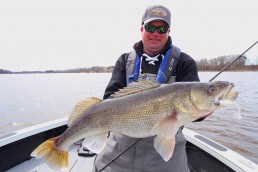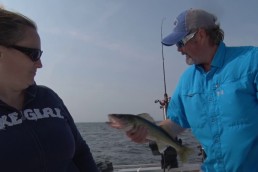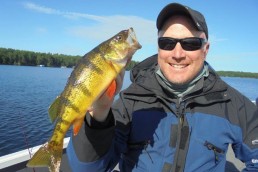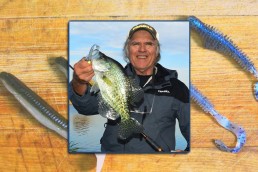Dragging and Slow-trolling Swimbaits
SHARE THIS POST
So often with walleye fishing, we get conditioned to think a certain way regarding a presentation. We fish live-bait rigs below the boat or we troll crankbaits or pitch jigs. Too often, we get locked into how a specific presentation should be fished. What’s detrimental to us growing as anglers is that we quit thinking and stop experimenting with how presentations can be potentially used. But by straying away from tradition and experimenting with what might seem unorthodox as uses for presentations, we can become more efficient.
Often, catching more fish is all about adapting to the location and what they are doing. This increases our efficiency dramatically. The reality is that most days, a walleye will eat a live-bait rig, jig, crankbait or anything else that lands in front of their face. But a correct presentation matched up with the right location can accomplish this sooner.
One hot tactic we see more in the Midwest is slow-trolling that incorporates soft plastic swimbaits. These baits have blown up in some regions, and, over time, we’ve become conditioned or engrained to fish them a certain way. Many anglers using swimbaits are casting them, and swimbaits shine when fished through weeds or up into shallow water. Anglers cast and reel these over the emerging vegetation, and these can be worked and twitched with a swim-and- stop cadence.
Swimbaits can be fished many ways. The stout single hook can be cast through weeds effectively to offer a good hook- up percentage. More leverage or pressure can be applied to the larger single hook compared to the much smaller hook and gap found on the treble hooks of crankbaits or even traditional jig-and-live-bait combinations. Swimbaits are ideal out over deeper water in 8 to 10 feet or more, and can be slowly dragged or trolled behind the boat, which can be deadly for reaching fish in 25 feet. These fish very well dragged behind a boat at a 45- to 80-degree angle and allow you to fish slower than traditional spinner harness and the crankbait speeds. You can crawl forward at 1 to 1.5 mph, or faster if necessary, but this wide window of speed can enable you to follow irregular weed bed edges and bottom contours that can be difficult at faster speeds.
Dragging soft plastics slowly upstream on river systems first planted the seeds for experimenting with slow-trolling swimbaits behind boats on reservoirs and lakes. There were a few earlier lessons as well, but somehow, out of my own stubbornness, I didn’t embrace these tactics for how effective they could be.
Years ago, I was guiding a couple on Devils Lake and the wind was blowing at 30 mph and boat control was a struggle as we were fishing a point. We were catching fish in 15 feet, and even with two large drift socks out, we struggled to slow the boat down. One of the anglers threw out a 1/4-ounce jig with a 3-inch twister-tail grub and simply dragged it behind our boat and started catching several nice fish. We replaced the other rods with more jigs and grubs and caught a lot of fish that day in fast order.
Are you enjoying this post?
You can be among the first to get the latest info on where to go, what to use and how to use it!
The next day, I went back to the bottom bouncer and spinner, so some lessons come hard. Dragging soft plastics behind the boat wasn’t something I easily embraced.
In my opinion, slow-trolling soft plastics work so well because of the hang time and the stalling abilities on the fall they have when popped off the bottom. As walleye anglers, we are conditioned to rig soft plastics on jigs for fishing below a boat or when pitching away from the boat. By simply changing our mentality, we can then expand the uses for soft plastics dramatically by fishing these baits with a “trolling mindset.”
Over the past five years, I’ve lit up big walleyes by trolling swimbaits over shallow reefs after dark. We have even caught scattered basin fish by running swimbaits behind planer boards. The only requisite seems to be a clean bottom, as it can be difficult to avoid any bottom contact unless targeting suspended fish. If there’s a lot of algae and anything else on the bottom that fouls up hooks, a crankbait or bottom bouncer and spinner often work. But if the bottom is clean, trolling or dragging swimbaits can be surprisingly effective. Whenever you need to either slow your speed down or need to fish closer to the boat to follow contours, swimbaits can give you a lot more flexibility.
Probably the biggest difference I see with pulling swimbaits versus crankbaits or spinner harnesses is that you often must set the hook. Compared to what I’d prefer for either crankbaits or harnesses, swimbaits seem to work better with a faster and heavier-action rod. A rod in the holder doesn’t seem to hook up with the same consistency when using swimbaits. Even when we used these behind planer boards, we often had to manually set the hook by sweeping the board forward. The swimbaits seem to require a more hands-on approach where you hold the rod and set the hook.
As more anglers experiment with all the different applications and utilize swimbaits for walleye fishing, I suspect that more refinements will continue to be made and shared. The versatility of these can enable anglers to catch more and bigger fish, and in many ways the swimbaits complement other traditional walleye presentations.
MWO
SHARE THIS POST
Did you enjoy this post?
You can be among the first to get the latest info on where to go, what to use and how to use it!
Jason Mitchell
Jason Mitchell was a top walleye guide on Devils Lake, N.D. for nearly 20 years. Today, Mitchell produces the Jason Mitchell Outdoors TV program. Visit jasonmitchelloutdoors.com for more.



